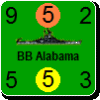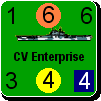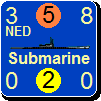rkr1958
Posts: 23483
Joined: 5/21/2009
Status: offline

|
Turn 5. May/June 1940. Axis #1. Blitzkrieg of Belgium.
OKH (army) in coordination with OKL (air force) devise a plan to capture Liege, Antwerp, Brussels and the Ardense forest hex at [54,32], which is directly northeast of Reims and west of the Maas river, before the British or French have any time to react (i.e., on the surprise impulse).
(1) The Ardense forest hex [54,32] will be captured using the II Para corps to drop into that hex and be supported in land combat against the single regiment (i.e., notional) defending by two corps and a division attacking from the hex directly east. This will be an automatic result and give the Wehrmacht a bridgehead west of the Maas river.
(2) Liege, Belgium will be assaulted with overwhelming force which will easily overcome in an automatic attack.
This leaves Antwerp and Brussels. Because of the bottleneck entering Belgium the Wehrmacht (alone) is only able to get 19 land combat factors against the 4 Belgium factors defending Antwerp and 36 against the 5 defending Brussels. Furthermore, the Wehrmacht will not be able to negate the -1 city modifier for Antwerp and will only be able to negate 1 of the -2 (city & factory) modifiers for Brussels. So this puts the initial land combat odds, prior to any help from the Luftwaffe, at +8.5 for the assault on Antwerp and +13.4 for Brussels. Both odds are way too low this early in the turn and at the start of Case Yellow. For an +8.5 assault (Antwerp), PWIN is only 87.5% and the chance of the attackers staying fully organized is only 24.5%. For Brussels at +13.4, while PWIN in 100% the chance of staying fully organized is 67.2%. Also, the chance of taking losses in the two attacks at those initial odds are 55% and 22.6%, respectively.
Goering and his Luftwaffe (OKL) has allocated four bomber and one fighter/bomber air flotilla to these attacks. These air flotillas have tactical factors of 3,3,4,5,5. During the surprise impulse these factors are doubled for ground support and ground strikes get two tries against each target. A successful ground strike will provide no more than +2 (i.e., 1 unit disorganized) to the land combats against Antwerp or Brussels. Even given two tries with a 5 factor bomber there's still a 25% chance that the ground strike will miss. On the other had, even using a lower 3 factor plan for ground support, which has its factor doubled to 6, that plane would provide a +3 modifier to the assault on Antwerp and +2.4 to the assault on Brussels. These modifiers are 100% (i.e., a sure thing). Now, if used in a ground strike this 3 factor plane would have only a 51% chance of providing +2 to the land combat. So in this instance using the allocated planes in ground support is no doubt superior to using any of them for ground strikes. Also, ground support uses no air missions meaning that the left over air missions can be used to rebase fighters to the new front lines to cover the spearheads.
Specific to these two attacks and the surprise impulse OKH developed two linear equation which they and OKL used for allocating the five available air flotillas as ground support to the Antwerp and Brussels attack.
For Brussels, ODDS = 2*{[36 + min(2*GS,36)]/5} - 1 and for Antwerp, ODDS = {[19 + min(2*GS,19)]/2} - 1
Ideally, for assault minimum odds of +21 provide for automatic victory without the chance for any losses or disorganization. However, as you shall see, that wasn't quite possible for both remaining land combats.
(3) Brussels. 3 air flotillas with tactical factors of 3,3,4 were assigned to ground support for Brussels. These factors, which were doubled to 20, provided an additional +8 and gave final assault odds of +21.4. The attack on Brussels is automatic without chance of loss or disorganization.
(4) Antwerp. The remaining 2 air flotillas, with tactical factors 5,5, were assigned to ground support for Antwerp. These factors, which were doubled to 20 but limited to 19 (i.e., constrained by the total number of (modified) land factors attacking) provided an additional +9.5 and gave final assault odds of +18. While with three attacking units this ensured a PWIN=100%, there was a 4% chance of taking a loss and a 6% of not staying fully organized. However, the attackers roll a 15, which gives a final result of 33. All is well.

 Attachment (1) Attachment (1)
_____________________________
Ronnie
|
 Printable Version
Printable Version



























 New Messages
New Messages No New Messages
No New Messages Hot Topic w/ New Messages
Hot Topic w/ New Messages Hot Topic w/o New Messages
Hot Topic w/o New Messages Locked w/ New Messages
Locked w/ New Messages Locked w/o New Messages
Locked w/o New Messages Post New Thread
Post New Thread